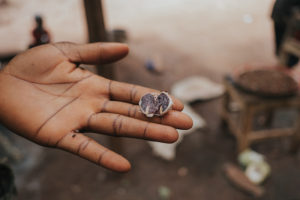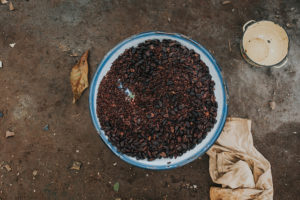
Cocoa is the primary source of income in southern Cameroon, where it represents 48% of total agricultural land use. In this and other tropical regions, the way cocoa agroforests are managed matters immensely to livelihoods, and also to the climate.
Cocoa agroforests vary widely in terms of tree composition and structure, but, until recently, few studies had been conducted to understand how these differences impact carbon stocks.
Meanwhile, irresponsible land management practices were not only seeing cocoa plantations fail to contribute to countries’ emissions reductions goals, but also cause massive forest degradation in countries such as the Côte D’Ivoire and Ghana, which are alone responsible for two-thirds of the world’s cocoa production.
This ‘cocoa belt’ had been becoming increasingly prone to deforestation and drought, and cocoa landscapes in other high-producing countries in Asia and Latin America had been following suit.
But when chocolate companies began making deforestation-related commitments at the UNFCCC COP21 in Paris, the tide began to change on the industry’s standards and practices. It also then became imperative for scientists to generate knowledge to help the expected changes transform cocoa forest landscapes in the most beneficial ways.
In response, CGIAR Research Program on Forests, Trees and Agroforestry (FTA) institution the Center for International Forestry Research (CIFOR) and other partner organizations profiled the carbon stocks of cocoa agroforests in three southern Cameroonian ecological areas (Yaoundé, Mbalmayo and Ebolowa) and identified what types of plants and management systems boost carbon storage best.
“This knowledge is important to implement nationally determined contributions [NDCs] to the global climate agenda and its measures to reduce emissions from deforestation and forest degradation [REDD+] by promoting sustainable cocoa value chains,” says lead author and CIFOR senior scientist Denis Sonwa.
Since COP21, the world’s largest chocolate companies – Mars, Nestle and Ferrero to name a few – have come together in a variety of agreements, from an agreement signed by the Prince of Wales to a sectorial “Frameworks for Action” at COP23 in Bonn, Germany. The goal is to see the industry achieve net-zero deforestation and improve local livelihoods, and this research is a crucial step along the way.
COCOA’S COMRADES
The researchers aimed to answer a string of questions including how carbon stocks of cocoa agroforests varied across ecological zones and management methods, and how carbon storage compared between different types of plants associated with cocoa – and the stocks of some key species, in particular.
“What we found is that agroforests with a high density of high-economic value industrial timber and non-timber forest products stored two to three times the amount captured by other management systems,” explains Sonwa.

Plantations with a high density of banana plants and oil palm trees came next, and those with cocoa tree densities of 70% or higher came in last. Specifically, the above-ground parts of plants in these varied types of cocoa agroforests stored 147 Mg of carbon per hectare, 49 Mg and 39 Mg, respectively.
Researchers also found that above-ground parts of the other plants accounted for 70% of the carbon storage, while cocoa trees accounted for only 5%.
Across all three ecological zones, high-value timber accounts for 29.7% of the total carbon stored above ground, at 49.9 Mg per hectare; edible species for 15%; and medicinal plants for 6%.
RICH PICKINGS
Another conclusion of the study is that “the top ten species generally stored more than 50% of carbon held by associated plants,” with Terminalia superba – a tall deciduous tree native to the African tropics – among the species with a higher storage (14 Mg per hectare).
These results “suggest that associated plants not only contribute to shade, but also increase the capacity of farms to store carbon,” notes the study. And the benefits of such plants go well beyond that. Indeed, the higher ecocapacity of cocoa agroforests lead to increases in plant litter fall, soil litter and rainfall, thus upgrading both the agronomic and environmental potential of the landscape. Meanwhile, a plantation solely growing cocoa does threaten overall agro-ecological sustainability.
Sonwa points out that non-cocoa plants provide a structure similar to that of forests, and that their products and services appear as cobenefits of cocoa agroforestry in addition to carbon storage. Timber, non-wood forest products such as fruit, and medicinal plants may all contribute to local livelihoods and to biodiversity conservation.
“Simultaneously obtaining several products and services from the same plantation increases the resilience of farmers,” he says. “That is particularly important as the pressure on natural resources increases.”
Read also: Greater inclusion of women is needed to optimally intensify cocoa value chains, researchers find
BEYOND THE BEANS
In the last few decades, the main goal of cocoa agroforests was to produce cocoa beans, but demographic growth, climate change and loss of forests are changing this approach.
For the researchers, the multiple functions of cocoa agroforests should be at the center of efforts to fight global warming and achieve better outcomes for people and the planet. “This is why our findings are useful to scientists, and also to decision-makers, farmers and the private sector,” says Sonwa.
The findings of the paper can, for example, be useful to certification schemes that want to improve the environmental footprint of the cocoa sector. They also offer key insights to cocoa agroforest managers, particularly given the current context where zero deforestation targets are at the center of many company agendas.
In Sub-Saharan Africa where most of the world’s cocoa originates, the paper is certainly useful in structuring efforts to free the cocoa value chain from deforestation. But going beyond that, in central Africa and the Congo Basin, it sheds light by offering productive agroforestry options that conserve remaining natural forests while providing livelihoods.
“We have examined cocoa agroforests from an ecological perspective, so the next step would be to look at economic and production aspects,” says Sonwa. “For example, does storing more carbon in associated plants affect cocoa production — and how?”
The findings make clear that sustainable cocoa agroforest management in Sub-Saharan African forest landscapes can reconcile cocoa bean production with climate change responses, and big global initiatives, such as the Sustainable Development Goals (SDGs).
But, it also makes clear how much there is left to learn about chocolate.
By Gloria Pallares, originally published at CIFOR’s Forests News.
For more information on this topic, please contact Denis Sonwa at d.sonwa@cgiar.org.
This research forms part of the CGIAR Research Program on Forests, Trees and Agroforestry, which is supported by CGIAR Fund Donors.
This research was supported by the International Institute of Tropical Agriculture, Sustainable Tree Crops Program (STCP) and Deutscher Akademischer Austauschdienst (DAAD).











